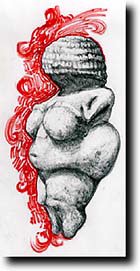| The Mother Goddess
The Venus of Willendorf
and other images worshipped by our ancestors
by Fiammetta Magnanensi We don't know when the human race began to think about the Earth as the Mother Goddess, the mother of all creatures and therefore of humans themselves. We do know however that she was worshipped and cerimonies and offerings were dedicated to her as thanks for what she gave.
The most ancient piece of evidence which has been found, dedicated to the goddess, is a stone statuette known as the Venus of Willendorf, after the place where it was found. It is a little Stone Age monument with wide hips and large breasts as if to indicate abundance and great procreating capacities. It is a work of art from the caverns, carved around 20,000 years ago, symbolising fertility and generosity.
The Venus of Willendorf.
Cambridge Archeological Museum (GB) 25,000-10,000 BC
(drawing by Filippo Mazzoli) |  | However, there are other examples of statuettes of the Mother Goddess, albeit not as ancient as that of Willendorf. Some anthropomorphic statuettes which seem linked to the goddess are those found during the archeological excavations in Bulgaria in the area formerly inhabited by the Thracians.
In fact, there was a cult dedicated to the Earth Goddess who, depending on the place, was called by different names. Cybele was the name of the goddess in the sanctuaries and caverns of Phrygia, Hypta was the goddess who ruled all the high, sunny mountains and Cotytto or Bendida was the goddess who lived in shadowy places and caverns. | 
| Mother Goddess
(clay, 13,5 cm. high)
late Neolitic, Karanovo,
Nova Zagora Province, Bulgaria | For the tribes of Thracia, the goddess was the protectress of Nature and all living creatures. She was invoked during the ceremonies for the ritual of Epiphany, during which her son, in the form of a bull, was torn to pieces and eaten raw, so that his strength would be passed on to the people. This meant that the bull was reborn and life could continue.
The Nuraghi peoples of Sardinia also worshipped the Earth Goddess, also known as Mater Mediterranea or Gran Mater. One of the best-known examples is the discovery, in a natural cave, of a basalt statuette around 14cm high, known as the "Veneretta" of Macomer. Like the Willendorf example, this one too has a generous figure as if to indicate femmininity and maternity. See also:
|